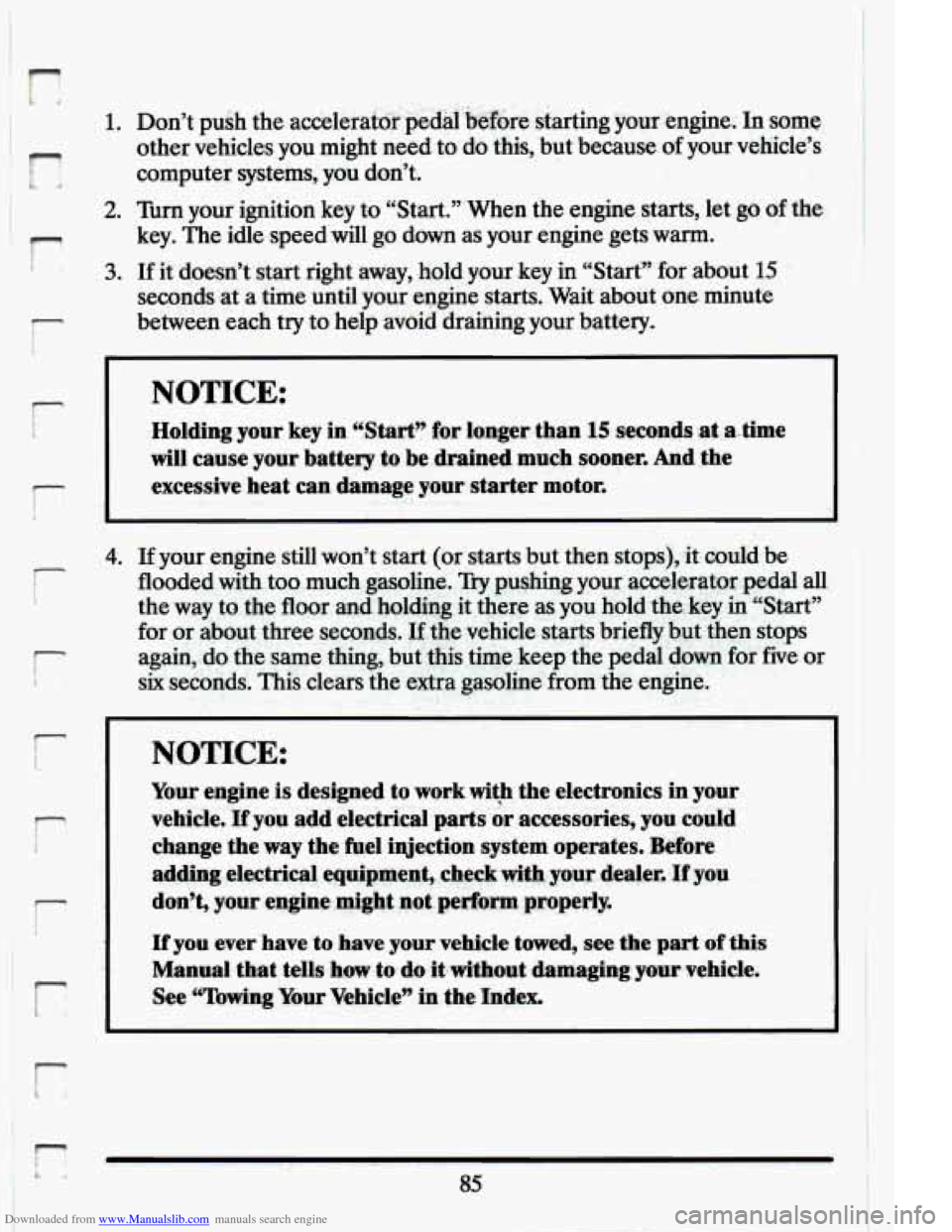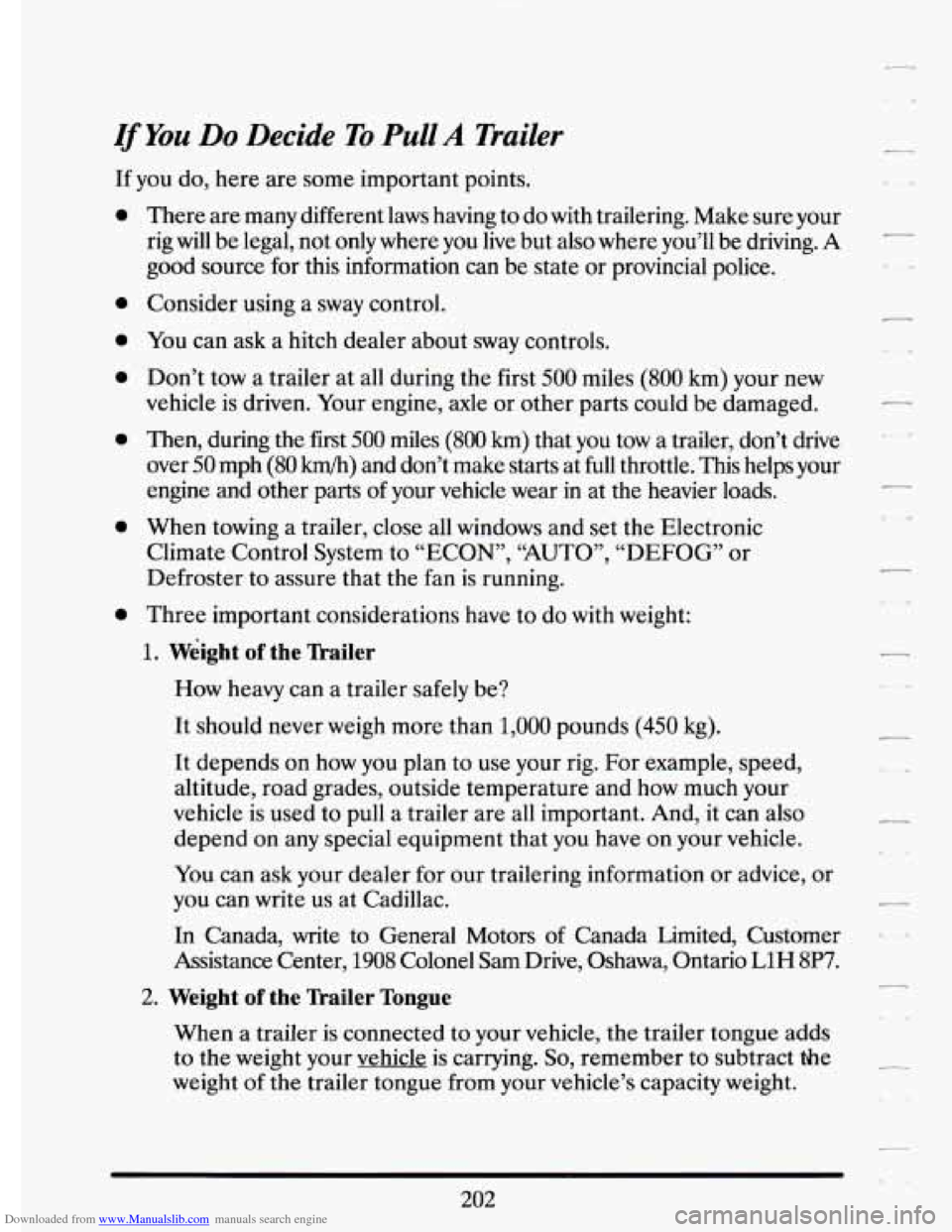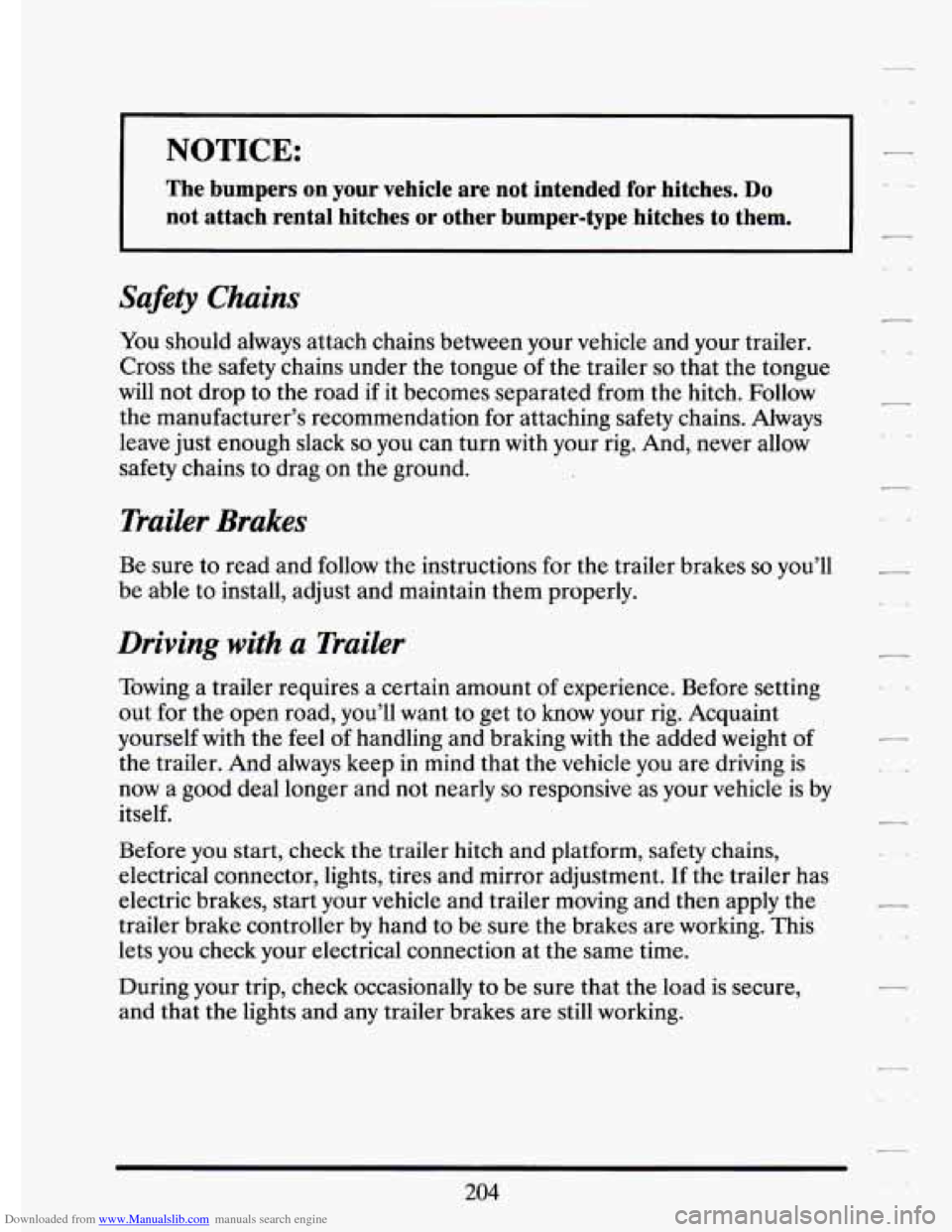Page 97 of 398

Downloaded from www.Manualslib.com manuals search engine r
r
i
I- i
i
r i
2. ?iun your ignition key to “Start.”’When the engine starts, kt go of the
key. The idle ,speed’will go down as your engine gets warm.
3. If it. doesn’t start right away, hold your key in “Start” for about 15 .
secondsat a time until your engine starts. Wait about one minute
between each try to help avoid draining your battery.
NOTICE:
.Holding your key in ‘4S.talrtn €or longer: than .15 seconds -at a. time
will cause your battery to,be drained much sooner. And ‘the
excessive heat can damage your starter motor.
NOTICE:
Your engine is designed to work with the electronics in your
vehicle.
If you add electrical parts ‘or accessories, you .could
change the
way the fuel iqjection system operates. Befwe
-adding de,c#rical equ:ipm&, check with,pur.dealer, :If you
don’t, your engine.might
not pedhn properly.
Lf you ever’have to have your vehicle towed, see $he part of this
Mamud ,that tells ‘how to do itwi@hout damaging- your ,vehicle.
See-‘6Towing. Your Vehicle”
in the hdex,
. _“
Page 103 of 398

Downloaded from www.Manualslib.com manuals search engine tf
r
I.
NOTICE:
If your vehicle seems to start up rather slowly, or if it seems not
to shift gears
as you go faster, something may be wrong with a
transaxle system sensor. If you drive very far that way, your
vehicle can be damaged.
So, if this happens, have pour vehicle
serviced right
away Until then, you can use “2” (Second Gear)
when you are driving less than
35 mph (56 h/h) and @)
(Overdrive) for higher speeds.
F 1, 3 (Third Gear)
This is like
@, but you never go into Overdrive.
Here are some times you might choose
“3” instead of @:
- When driving on hilly, winding roads
- When towing a trailer, so there is less shifting.between gears
- When going down a steep hill
2 (Second Gear)
This position gives you more power but lower fuel economy. You can
use
“2” on hills. It can help control your speed as you go down steep
mountain roads, but then you would also want
to use your brakes off
and on.
r NOTICE:
Don’t drive in (‘2” (Second Gear) for more than 5 miles (8 km),
or at speeds overS5 mph (88 km/h), or you can damage your
transaxle.
Use “@)” or c63” as much as possible.
Don’t shift into
“2” u.nless you are going slower than 65 mph
(105 Wh), or you can damage your engine.
91
Page 106 of 398
Downloaded from www.Manualslib.com manuals search engine If you are towinr a trailer and are parking on any hill: See “Towing a
Trailer” in the Index. That section shows what to do first to keep the
trailer from moving.
SHIFTING INTO “P9’ (PARK)
Steering Column ShijZ Lever
1. Hold the brake pedal down with your right foot.
94
Page 112 of 398
Downloaded from www.Manualslib.com manuals search engine RUNNING YOUR ENGINE WHILE YOU’RE
PARKED
It’s better not to park with the engine running. But if you ever have to,
here are some things to know.
Follow the proper steps to be sure your vehicle won’t
move. See “Shifting
Into
‘P’ (Park)” in the Index.
If you are parking on a hill and if you’re pulling a trailer, also see “Towing
a Trailer” in the Index.
100
Page 144 of 398

Downloaded from www.Manualslib.com manuals search engine the manual’s advice. Waiting to do repairs can be costly -- and even
dangerous.
So please get to know your warning lights. They’re a big help.
Your vehicle may also have a driver information system that works along
with the warning lights. See “Driver Information System”
in the Index.
Brake System Warning Light
If the warning light comes on, there could be a brake problem. Have your
brake system inspected right away.
Your Cadillac’s
hydraulic brake system
is divided into two
parts. If one part isn’t
working, the other part
can still work and stop
you. For good braking,
though, you need both
parts working well.
This light should come
on as you start the vehicle. If it doesn’t come on
then, have it fixed
so it will be ready to warn you if there’s a problem.
If the light comes on while you are driving, pull off the road and stop
carefully.
You may notice that the pedal is harder to push. Or, the pedal
may go closer to the floor. It may take longer to stop. If the light
is still
on, have the vehicle towed for service. (See “Towing Your Vehicle” in the
Index.)
132
Page 213 of 398

Downloaded from www.Manualslib.com manuals search engine r
r
r
P
r
!
r I
r
r-
NOTICE:
Pulling a trailer improperly can damage your vehicle and result
in costly repairs not covered by your warranty. To pull a trailer
correctly, follow the advice
in this section.
Your Cadillac is a passenger vehicle. It was not designed for many of the
demands that trailer towing can add.. Trailer towing can change the way
your vehicle performs on the road. It brings new forces into play and can
add plenty
of strain and stress to your vehicle.
Load pulling components such as the engine, transaxle, wheel assemblies,
and tires are forced to work harder against the drag
of the added weight.
The engine is required to operate at relatively higher speeds and under
greater loads, generating extra heat. Trailer towing adds considerably to
wind resistance increasing the pulling requirements.
All
of that means changes in:
Handling
Durability
Fuel Economy
You may decide not to pull a trailer but meet your load carrying needs in
some other way.
201 I
I
Page 214 of 398

Downloaded from www.Manualslib.com manuals search engine If You Do Decide To Pull A Trailer
If you do, here are some important points.
0
0
0
e
0
0
0
There are many different laws having to do with trailering. Make sure your
rig will be legal, not
only where you live but also where you’ll be driving. A
good source for this information can be state or provincial police.
Consider using
a sway control.
You can ask a hitch dealer about sway controls.
Don’t tow a trailer at all during the first
500 miles (800 km) your new
vehicle is driven. Your engine, axle or other parts could be damaged.
Then, during the first
500 miles (800 km) that you tow a trailer, don’t drive
over
50 mph (80 km/h) and don’t make starts at full throttle. This helps your
engine and other parts of your vehicle wear in at the heavier loads.
When towing a trailer, close all windows and set the Electronic
Climate Control System to
“ECON”, “AUTO”, “DEFOG” or
Defroster to assure that the fan is running.
Three important considerations have to do with weight:
1. Weight of the nailer
How heavy can a trailer safely be?
It should never weigh more than 1,000 pounds
(450 kg).
It depends on how you plan
to use your rig. For example, speed,
altitude, road grades, outside temperature and how much your
vehicle is used to pull
a trailer are all important. And, it can also
depend on any special equipment that you have on your vehicle.
You can ask your dealer
for our trailering information or advice, or
you can write
us at Cadillac.
r
r.
In Canada, write to General Motors of Canada Limited, Customer L .
Assistance Center, 1908 Colonel Sam Drive, Oshawa, Ontario L1H 8P7.
2. Weight of the nailer Tongue
When a trailer is connected to your vehicle, the trailer tongue adds
to the weight your vehicle is carrying.
So, remember to subtract the
weight
of the trailer tongue from your vehicle’s capacity weight.
202
--
Page 216 of 398

Downloaded from www.Manualslib.com manuals search engine NOTICE:
The bumpers on your vehicle are not intended for hitches. Do
not attach rental hitches or other bumper-type hitches to them.\
-
Safety Chains
You should always attach chains between your vehicle and your trailer.
Cross the safety chains under the tongue of the trailer
so that the tongue
will not drop to the road
if it becomes separated from the hitch. Follow
the manufacturer’s recommendation for attaching safety chains. Alwa\
ys
leave
just enough slack so you can turn with your rig. And, never allow
safety chains to drag on
the ground.
Trailer Brakes
Be sure to read and follow the instructions for the trailer brakes so you’ll -
be able to install, adjust and maintain them properly. L:
Driving with a Trailer
Towing a trailer requires a certain amount of experience. Before setting
out for the open road, you’ll want to get to know your rig. Acquaint
yourself with the feel of handling and braking with the added weight of
the trailer. And always keep in mind that the vehicle you are driving is
now a good deal longer and not nearly
so responsive as your vehicle is by
itself.
Before you start, check the trailer hitch and platform, safety chains,
electrical connector, lights, tires and mirror adjustment. If the trailer has
electric brakes, start your vehicle and trailer moving and then apply the
trailer brake controller by hand to be sure the brakes are working. This
lets you check your electrical connection at the same time.
During your trip, check occasionally to be sure that the load is secure,
and that the lights and any trailer brakes are still working.
204